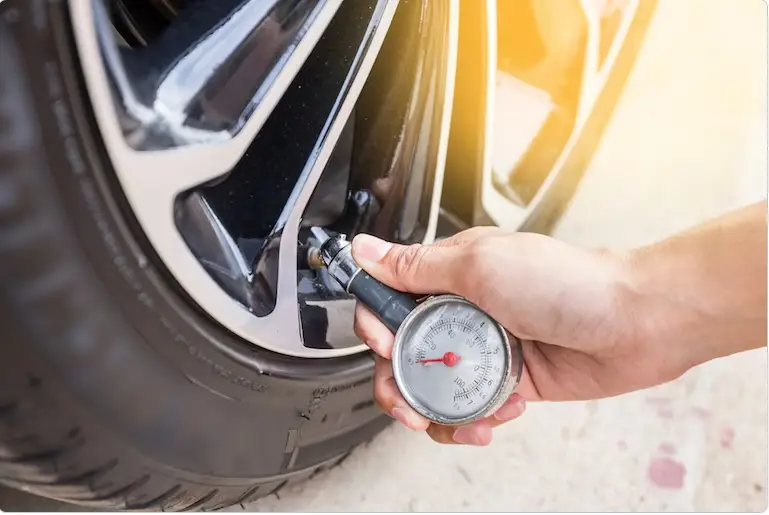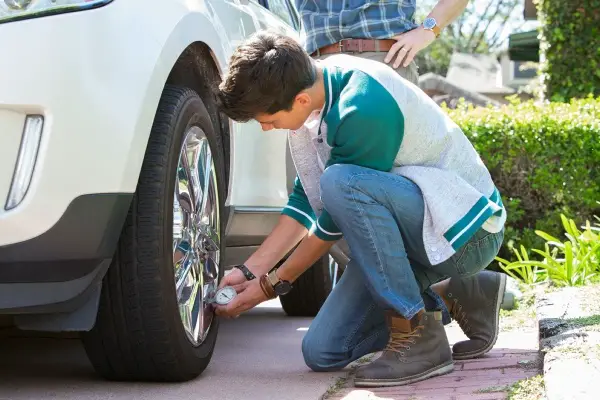We all want our cars to stay in the best possible shape. So our primary focus is always to keep them clean and in good condition. Now while cleaning the car tires you may have come across some specifications on your tire like 80 or 90 psi.
But why does your tire says 80 psi cold?
“Tire says 80 psi cold” means that the recommended tire pressure for the specific tire is 80 pounds per square inch (psi) when the tire is cold. This is the pressure that should be maintained in the tire when it has not been driven on for several hours.
Want to know more about this psi? Well, let’s dive into details right away then.
Tire Says 80 psi Cold: What Does It Mean?
“Tire 80 psi cold” refers to the recommended cold inflation pressure for a tire, which is 80 pounds per square inch (psi). This means that the tire manufacturer recommends inflating the tire to a pressure of 80 psi when the tire is cold.
Cold inflation pressure is the tire inflation pressure before the car is driven and the tires are warmed up.
The owner’s handbook and the sign (or sticker) that is attached to the vehicle’s door edge, glove box door, or gasoline filler flap typically state the recommended cold inflation pressure. It might even be visible on the tire surface as well.
Cold vs Hot Tire Pressure: What’s the Difference?
The main difference between cold and hot tire pressure is the temperature of the tire when it is measured. Cold tire pressure refers to the air pressure in the tire when it is at or near the ambient temperature of the environment. This is usually before the vehicle has been driven for an extended period of time.
Hot tire pressure, on the other hand, refers to the air pressure in the tire when it has been driven for an extended period of time and has heated up due to friction and internal heat generated by the tire.

The pressure of a tire will increase as it heats up, causing the hot tire pressure to be higher than the cold tire pressure. Therefore, it is important to ensure that the tire pressure is checked and adjusted when the tires are cold.
This is the recommended pressure for the safe and efficient operation of the vehicle. If the tire pressure is adjusted when the tires are hot, it may result in overinflation when the tires cool down. This can cause issues such as reduced tire life, poor handling, and increased risk of tire failure.
How Does Tire Pressure Affect Tire Performance?
Tire pressure is a crucial factor that affects the performance and safety of a vehicle. The correct tire pressure is important because it helps ensure that the tire’s shape and size remain optimal for the load it is carrying.
Just like putting 18-inch tires on 17-inch rims would be a very foolish and dangerous thing to do, the same goes for over or underinflating your car tires.
A tire that is overinflated or underinflated will not perform as well as a tire that is properly inflated. When a tire is underinflated, it can cause the tire’s sidewall to flex more than normal.
This can lead to increased rolling resistance, which makes the vehicle harder to handle, reduces fuel efficiency, and can cause the tire to overheat and fail prematurely. Underinflated tires can also cause uneven tread wear, reducing tire life and performance.
Overinflated tires, on the other hand, have a smaller contact patch with the road surface. This can reduce traction and handling, making the vehicle more difficult to control.
Overinflation can also cause the center of the tire to wear out more quickly than the rest of the tire, leading to uneven tread wear and a shorter tire lifespan.
This is why it’s important to check tire pressure regularly, especially before long trips or when carrying heavy loads, and adjust the pressure as necessary. Properly inflated tires can help improve fuel efficiency, handling, and safety, while also extending the life of the tire.
How to Check Tire Pressure?

Checking tire pressure is a simple process but a very important one. Make sure to check the recommended pressure in the manual before because tires like 325 and 35 are not the same, so the tire pressure is also different.
You can check the pressure with a tire pressure gauge. You can purchase a tire pressure gauge at an auto parts store or online.
Make sure to choose a gauge that matches the type of valve stem on your tires(either a Schrader or Presta valve). And you need to check the vehicle’s owner’s manual or the tire information placard to find the recommended tire pressure for your vehicle.
Now let’s take a look at the steps to check tire pressure:
- Step 1: First, you need to unscrew the valve cap on the tire’s valve stem and set it aside.
- Step 2: Next, press the tire pressure gauge onto the valve stem and hold it firmly in place. The tire pressure gauge will display the current tire pressure in pounds per square inch (PSI).
- Step 3: After that, you will have to compare the reading to the recommended tire pressure for your vehicle. If the tire pressure is too low, use an air compressor or tire inflator to add air to the tire until it reaches the recommended pressure. If the tire pressure is too high, use the tire pressure gauge to release air until it reaches the recommended pressure.
- Step 4: You will have to repeat the process on all four tires to ensure they are properly inflated.
- Step 5: After that screw the valve cap back onto the valve stem to prevent dust and debris from entering the valve.
If the steps are confusing to you here is a video guide for checking tire pressure-
Regularly checking tire pressure is important for maintaining the safe and efficient operation of your vehicle, as well as maximizing the lifespan of your tires. Tire pressure should be checked at least once a month.
You should check pressure before long trips, to ensure that the tires are properly inflated. It is also a good idea to check the tire pressure after any sudden temperature changes, as this can cause the tire pressure to fluctuate.
How to Maintain the Correct Tire Pressure?
Whether your tire will last a long time or not depends on how well you maintain it. So, along with checking tire pressure regularly, you can take the following steps to ensure correct tire pressure throughout-
- Check tire pressure at least once a month and before long trips, to ensure that your tires are properly inflated. Make sure to use a reliable tire pressure gauge that is appropriate for the valve stem on your tires
- Check tire pressure when the tires are cold, before driving, or at least three hours after driving. This is because tire pressure can increase when the tires are warm.
- Follow the recommended tire pressure for your vehicle, which can be found in the owner’s manual or on the tire information placard. Overinflated vehicle tires can be dangerous so try to stay within the recommended pressure.
- Make sure to inflate all four tires evenly to ensure optimal handling and tire wear. Avoid over-inflating or underinflating your tires.
- Inspect your tires regularly for signs of wear or damage, such as low tread depth, cracks, or bulges. Make sure to replace any damaged or worn tires as soon as possible.
Frequently Asked Questions (FAQs):
Are Tires Able to Handle 80 Psi?
This is dependent on your specific vehicle. According to car manufacturer recommendations, passenger tires should be inflated to a minimum of 30 to 33 PSI and a maximum of 50 to 52 PSI. Truck tires, on the other hand, have a maximum pressure of 70 to 80 psi and are typically inflated to roughly 50 psi.
Are Tires Capable of 100 PSI?
Unless a tire is made particularly to withstand such high pressure, 100 PSI is too much for car tires. The pressure range that the tire manufacturer specifies is the range within which tires are intended to function. But for bikes, the recommended pressure is around 80-100 PSI.
Does Cold Cause An Increase in PSI?
No, the cold temperature usually decreases tire pressure, as the air inside the tire contracts when it is exposed to colder temperatures. This means that the tire pressure can drop by 1-2 psi (pounds per square inch) for every 10 degrees drop in temperature.
End Words
That’s the end of our discussion on the tire says 80 psi cold. Hopefully, you are now well aware of the reason why your tire placard or engravings says such a specific number.
If there are any worrying signs regarding your tire pressure dont hesitate to take it to a mechanic or a garage. They will be able to solve the issue within minutes without causing any more damage to your car.
Until next time, happy driving!
